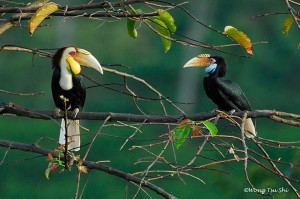Week 22 – 11 December 2016:
Silly Bird, Smart Bird
Hornbills are ridiculous. Just look at them. They are among the silliest-looking creatures ever. Outrageous they may be, but they are not dimwitted when it comes to solving the challenges of life.
There is a fundamental principle in community ecology that states that perfect competitors cannot coexist. If members of two species attempt to exploit the same essential, limited resource in the same place at the same time in the same way, one will be eliminated. This ecological principle is so entrenched in the discipline that it even has a name – competitive exclusion.
How then do three species of large hornbills, all doing essentially the same thing with their lives, manage to co-exist in the tropical forests of far-northeastern India? Rohit Naniwadekar of Manipal University, Charudutt Mishra and Aparajita Datta of the Nature Conservation Foundation in Karnataka set out to discover how these hornbills exploit limited food resources in slightly different ways, allowing them to occupy the same regions at the same time. This was part of Naniwadekar’s Ph.D. study.
The three bird species under consideration were the Great Hornbill (considered by the IUCN to be near-threatened), Wreathed Hornbill (of least conservation concern), and the Rufous-necked Hornbill (vulnerable to extinction). The study was conducted over a period of more than two years in the Namdapha Tiger Reserve in Arunachal Pradesh. In what ways did these birds differ in the way that they exploited fruit in forest trees?
After tramping endless kilometres along forest trails, Namiwadekar and his coworkers found subtle differences in the diet and behaviours of the hornbills that allowed them to defeat competitive exclusion. Although all three species had a varied fruit diet, Great Hornbills spent much more time dining on figs than they did on non-fig fruits. Upon finding a suitable fig tree, they spent an average of 21 minutes feeding there before moving on. Wreathed and Rufous-necked hornbills spent a greater proportion of their time foraging from non-fig fruit trees, where they averaged 43 minutes and 10 minutes respectively.
Wreathed and Rufous-necked hornbills behaved differently in their search for food, allowing them to both exploit non-fig fruit trees. Wreathed Hornbills travelled long distances in search of fruit, which was energetically costly but provided abundant opportunity to find areas with the highest fruit availability. In contrast, Rufous-necked Hornbills were more sedentary, and kept themselves well informed about the availability of fruit over a much smaller home range. Even though they had similar diets, Wreathed and Rufous-necked Hornbills employed different solutions to the trade-off between travel costs and foraging efficiency.
Given that these species have somewhat different diets, and exploit food resources in different ways, Naniwadekar et al. concluded that: “the three sympatric hornbills play a complementary role in seed dispersal.”
When I contacted her about the hornbill study, Datta explained that it is necessary to follow the birds for long periods in order to understand some aspects of their behaviour; this is particularly difficult in dense tropical forests. Hornbills “are wary of people due to hunting in most areas… There are often physical and logistical challenges working in remote tropical forests, where research is mostly on foot, heavy rains often disrupt work, malaria is common, while leeches and ticks… are also common.
Of the hornbills the group studied, the Rufous-necked is in the greatest peril. They have been extirpated from Nepal, and have a very restricted distribution in India. They may be found at altitudes as high as 2000 metres. Most regrettably, many of the forests at higher elevations are not legally protected, and the Rufous-necked Hornbill is hunted by some of the tribal communities for their beaks and feathers. Studies like the one by Naniwadekar and his colleagues will provide insights into hornbill biology that could have implications for their conservation.
Naniwadekar, R., C. Mishra and A. Datta. 2015. Fruit resource tracking by hornbill species at multiple scales in a tropical forest in India. Journal of Tropical Ecology 31:477-490.
Photo credits: Rufous-necked and Wreathed Hornbills - orientalbirdimages.org (Rufous-necked Hornbill (c) Ateeb Hussain; Wreathed Hornbill (c) Wong Tsu Shi); Great Hornbill – Pinterest




